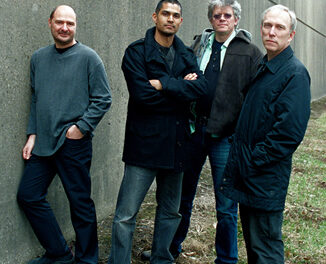With its drama-packed evening, the Alexander String Quartet engaged the listeners gathered in Duke University’s Reynolds Industries Theater on the west campus, bringing to a close the Chamber Arts Society/Duke Performances illustrious season of ten chamber ensembles. The attractively balanced program for the evening embraced three quartets: two late quartets–Mozart’s final quartet, K.590, and the penultimate quartet by Schubert, “Death and the Maiden,” D. 810, that framed one of Shostakovich’s vibrant middle quartets, Op. 108.
In the opening work, Mozart’s Quartet No. 23 in F, K. 590 (1790), the members of the Alexander Quartet spread their creamy, velvety, well-blended sound throughout the hall, which the audience met with a nearly imperceptible “ah” at the end. In the fast passagework of the fourth movement, the players, like a wind, swirled seamlessly through their notes as the sequences moved through countless permutations. It was a fun moment when, in the middle of that movement that was then in the key of C, they emphasized the D-flat major chord with gusto, effectively accentuating the shocking change at the point.
The Alexander Quartet’s generally calm reading of the Mozart set up a stark contrast between it and the next work, Shostakovich’s Quartet No. 7 in F-sharp minor, Op. 108. Written in 1960 and dedicated to the memory of his first wife, Nina, the work also emerged from a thaw in the long suppression of poetry and music in the U.S.S.R. The work of twelve minutes, the shortest of his string quartets, marks a release of his creativity with its three movements performed as three sections of an integrated whole.
The quick moving motives of tightly packed whole tones and semitones in the first movement, mostly assigned to the highly capable first violinist, Zacharias Grafilo, propelled the movement into a sprightliness. Later staccato chords and a melodic dialogue between the first violinist and cellist, Sandy Wilson, affirmed the animated vitality, so ably conveyed by all four members of the Quartet.
Their interpretation of the slow second movement portrayed feelings (perhaps of a furrowed brow) through plaintive musical lines thoughtfully shaped by the first violinist, violist Paul Yarbrough, and the cellist. The second violinist, Frederick Lifsitz, deftly glued these lines together with arpeggiated sixteenths, and later with a rhythmic figure I imagined to symbolize a troubled heartbeat.
After the third movement opened with a frantic version of the opening motive of movement one, it exploded into a fugue, sometimes stridently, possibly depicting anger, which the Alexander Quartet performed with almost virulent energy. This outburst dissipated as they performed so beautifully the waltz-like Allegretto. The four performers drew attention to the flow of feelings from beginning to the end. The listener could choose his own narrative, or concoct one from Shostakovich’s feelings about his first wife or the composer’s reactions to the political atmosphere surrounding his musical life.
After intermission, the Alexander Quartet continued to reveal its ability to handle contrast with its wonderful performance of Schubert’s Quartet No. 14 in D minor, D. 810. That Schubert set all four movements in minor keys highlights the drama and fire found in the work. The intensity that Schubert expressed in much of the first, third, and fourth movements pushed members of the Quartet to produce as much sound as possible. The resonance they achieved without going over the edge into roughness demonstrated their considerable tonal control. Schubert used his unusual gifts for spinning lyrical melodies to provide relief from the forceful sections, which the Quartet approached with colors of warmth and sweetness.
Schubert borrowed material from two of his previously composed works as a basis for the second and third movements. For the second, he drew on the simple melody from the “death” portion of his earlier song, “Der Tod und das Mädchen,” D. 531 (1817), which the Alexander musicians performed with utter beauty like that of highly trained singers. The Quartet’s close attention to interpretive detail shined brightly again in variation 4 and the coda with their decision to bring out certain lines that were obscured by compact close-spaced harmonic writing.
For the third movement, Schubert extracted the opening rhythm and its bass line from his sixth dance in “12 Deutsche Ländler,” for piano, D. 790/6 (1823). Since the original served as danceable music, the first beats of many measures in the quartet music are frequently marked strongly, and the Quartet performed these to the hilt.
The fourth movement takes off in a breathless saltarello, a frolicsome dance of Italian origin. After the Quartet members chased this one off the page at the end, the enthusiastic audience rose exuberantly to their feet.
The group returned for a most unusual but delightful encore. They performed an arrangement for string quartet by Grafilo of Brahms’s Intermezzo in A for piano, Op. 118/2. The cellist played the left hand of the original piano part with just the right amount of rubato, as would a sensitive pianist. In the hands of the Alexander Quartet, the unusual selection worked extremely well, satisfying the listener’s ear, like eating a Belgian chocolate after a fine meal.
In opening remarks at the beginning of the concert, Dr. George Gopen, Director, Chamber Arts Society of Durham, recognized Kathy Silbiger for her many years of highly effective service on its board. He also spoke about the 2013-14 Chamber Arts Series’ change of venue to the newly-renovated Baldwin Auditorium (with adequate parking!), including a shift from general admission to assigned seats, now being offered on a first-come, first-serve basis (919-684-4444).












